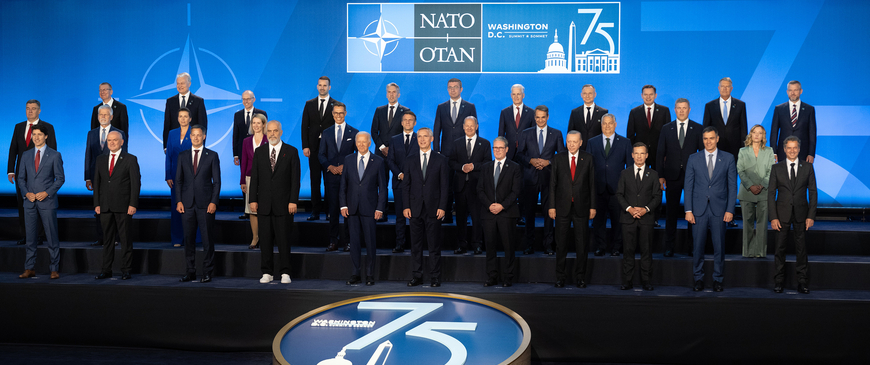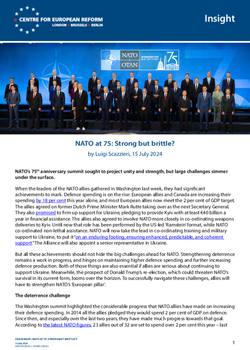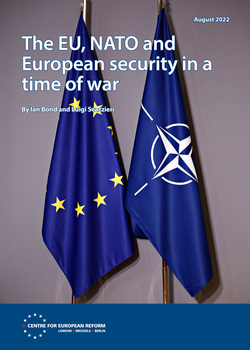
NATO at 75: Strong but brittle?
NATO’s 75th anniversary summit sought to project unity and strength, but large challenges simmer under the surface.
When the leaders of the NATO allies gathered in Washington last week, they had significant achievements to mark. Defence spending is on the rise: European allies and Canada are increasing their spending by 18 per cent this year alone, and most European allies now meet the 2 per cent of GDP target. The allies agreed on former Dutch Prime Minister Mark Rutte taking over as the next Secretary General. They also promised to firm up support for Ukraine, pledging to provide Kyiv with at least €40 billion a year in financial assistance. The allies also agreed to involve NATO more closely in co-ordinating weapons deliveries to Kyiv. Until now that role has been performed by the US-led ‘Ramstein’ format, while NATO co-ordinated non-lethal assistance. NATO will now take the lead in co-ordinating training and military support to Ukraine, to put it “on an enduring footing, ensuring enhanced, predictable, and coherent support.” The Alliance will also appoint a senior representative in Ukraine.
But all these achievements should not hide the big challenges ahead for NATO. Strengthening deterrence remains a work in progress, and hinges on maintaining higher defence spending and further increasing defence production. Both of those things are also essential if allies are serious about continuing to support Ukraine. Meanwhile, the prospect of Donald Trump’s re-election, which could threaten NATO’s survival in its current form, looms over the horizon. To successfully navigate these challenges, allies will have to strengthen NATO’s ‘European pillar’.
The deterrence challenge
The Washington summit highlighted the considerable progress that NATO allies have made on increasing their defence spending. In 2014 all the allies pledged they would spend 2 per cent of GDP on defence. Since then, and especially over the last two years, they have made much progress towards that goal. According to the latest NATO figures, 23 allies out of 32 are set to spend over 2 per cent this year – last year only ten did so. Many European countries are well above that figure, notably Poland which is over 4 per cent. Germany, which had long been a laggard, has hit 2 per cent. And, even though some European countries, like Italy, Spain and Belgium, are still below the target, the European members of NATO taken together will be above 2 per cent this year.
The Washington summit highlighted the considerable progress that NATO allies have made on increasing their defence spending.
NATO has also made much progress in terms of strengthening its deterrence posture. After Russia’s full-scale invasion of Ukraine in 2022, the allies agreed they would shift from having small ‘tripwire’ forces along the border with Russia to having much larger forces there to better deter an incursion. NATO created four new multinational formations of around 1000 troops – so called battlegroups – respectively stationed in Romania, Hungary, Bulgaria and Slovakia. These complemented four pre-existing ones in the three Baltic states and Poland, which were strengthened. At the 2022 Madrid summit, the allies decided to increase the number of troops at high readiness from 40,000 in 15 days to 300,000 in 30 days. The allies also agreed that the battlegroups would be further strengthened to brigade size (around 5,000 troops), but only “where and when required”. Finally, at the 2023 Vilnius summit, the allies agreed on new defence plans which spell out how NATO forces are meant to act in a crisis. According to the top NATO military official in Europe, NATO already has 300,000 troops at high readiness. As to the battlegroups, the ones in Estonia, Lithuania and Poland can be reinforced to brigade level quickly.
These achievements are significant. But the battlegroups in the Baltic states are still too small to be an effective deterrent against Russian aggression, as they could be overrun quite quickly. NATO would then have to retake the Baltic States in offensive operations, which would be complex, costly and politically divisive – not least as Russia would probably threaten to use nuclear weapons in defence of its territorial gains. Further strengthening the battlegroups in the Baltic states is essential to minimising the chances of a Russian attack. However, there are currently only plans to upgrade the battlegroups in Lithuania and Latvia to brigade-sized formations. In Latvia’s case that process will not be complete until 2026, and in Lithuania’s until 2027.
The battlegroups in the Baltic states are still too small to be an effective deterrent against Russian aggression.
There is a strong case to accelerate those plans, and to also permanently strengthen the battlegroup in Estonia to brigade size. At the same time, the 32 allies will need to ensure that their regional defence plans are properly resourced and can be fully executed. That will mean ensuring that there are enough forces assigned to the plans, and that they regularly exercise together. Analysts are doubtful over whether all these forces are currently at the required level of readiness. Moreover, only a few European allies would currently be able to send a brigade to fight in the Baltics. And, despite the rise in defence spending, European forces face big gaps in areas such as ammunition stocks, air defence and long-range strike weapons.
The Ukraine challenge
Increasing defence production is also essential if allies are serious about continuing to support Ukraine. The summit communiqué states that Ukraine’s path to NATO is “irreversible”. But the allies did not issue Ukraine with an invitation, and there is no timeline for membership. Instead, Ukraine will join “when Allies agree and conditions are met.” But even if Ukraine meets NATO’s conditions on the needed democratic, economic and security sector reforms, agreement between the allies will remain unattainable until the conflict winds down, since most countries see the risk of direct conflict with Russia as too great.
The NATO allies’ red lines have shifted over time, and many countries have provided Ukraine with advanced weapons and relaxed restrictions on their use. However, there is little sign that any country is contemplating deeper involvement than arming Ukraine. The 32 are unsparing in their rhetorical criticism of Russian air attacks on civilians and infrastructure, but so far have not taken on a more active role in defending Ukraine’s skies. That sharply contrasts with how some of them, including the UK, the US and France, helped shield Israel against the barrage of Iranian missiles and drones launched in April this year.
European countries have substantially increased their support for Kyiv over the past year. According to the Kiel Institute’s Ukraine Support Tracker, the US is still the single biggest provider of military assistance, with over €50 billion allocated since February 2022. But European countries are now not far behind, having allocated over €47 billion collectively. Despite this, large gaps remain, compared to what Ukraine would need, in terms of ammunition, air defence systems to protect its citizens and long-range weapons to push back Russian forces. The pledge of providing Ukraine with €40 billion a year is important, but in practice it would mean that Ukraine would continue to receive the same level of assistance as in previous years, not more. Moreover, it is much less than the €100 billion that Stoltenberg had initially sought. And, while each ally is supposed to contribute in proportion to its GDP, the target is non-binding.
The Trump risk
The prospect of a second Trump presidency looms large over NATO’s future, threatening its survival in its current form. In his first term, Trump accused Europeans of freeriding on the US and viewed the alliance as a ‘protection racket’, accusing many allies of not paying their dues. He also threatened to withdraw from the alliance. If he is re-elected, Trump is likely to prove even more disruptive to NATO. First, Trump will be able to draw on a cadre of Republicans aligned with his thinking to staff a new administration. Many of them think that Europeans will only spend more on defence if the US firmly signals its intention to focus on China by shifting forces away from Europe. Second, the much higher risk of conflict means that Trump’s rhetoric on NATO is likely to be more damaging. In particular, Trump’s questioning of whether he would come to the allies’ defence risks fatally undermining NATO’s deterrent power and potentially inviting Russian aggression. To mitigate some of the risks of a Trump presidency, last year Congress passed legislation that would prevent the president from withdrawing from NATO. However, that would not prevent Trump from damaging NATO in other ways. For example, he may refuse to appoint an ambassador, appoint a hostile ambassador, or fail to attend NATO summits. The legislation is also unlikely to prevent Trump from shifting US forces away from Europe. If the US did withdraw forces, Europeans would struggle to muster the numbers that would credibly deter Russia. Putin would hardly be deterred by European forces that could run out of ammunition in a few days or weeks. That would be true particularly if Trump creates doubts about the US’s willingness to use its nuclear arsenal to defend allies.
The prospect of a second Trump presidency looms large over NATO’s future.
When it comes to Ukraine, Trump’s policy remains unclear. Trump has been sceptical of further military assistance to Ukraine, delaying the most recent US aid package for months. He has also claimed he would solve the conflict rapidly, presumably by pushing Ukraine to give up territory. On other occasions, however, Trump has seemed open to providing Ukraine with military assistance, for example if structured as loans rather than grants. Many European officials hope that Trump may eventually be persuaded to continue to provide Kyiv with assistance, particularly if he tried and failed to reach a deal with Putin. Still, there is a clear risk that Trump will reduce or completely cut US assistance to Ukraine.
A change in US policy towards Ukraine would divide NATO and put the alliance in a difficult position. Supporting Ukraine would immediately become more challenging, as Europeans would need to provide even more assistance. But there would also be political difficulties. Some countries, like Hungary or Slovakia, would welcome a reduction in US assistance. Countries in which there is substantial public scepticism about supporting Ukraine, like France, Germany and Italy, could also reduce, or not increase, their assistance. Strong supporters of Ukraine, like the UK, Poland, the Baltics and the Nordic countries, would be faced with very difficult choices. They could continue to support Kyiv, and they may even be willing to provide it with more direct support, fearing that Putin could embark on further aggression if Russia wins in Ukraine. However, by becoming more directly involved on the ground, they could alienate Trump, who would be angry about his allies potentially dragging the US into a conflict with Russia and could withdraw US security guarantees. The only certainty is that NATO would be divided.
Towards a European pillar of NATO?
If Trump is re-elected, European members of NATO will be in a difficult position. But if Trump were to lose to Joe Biden or another Democrat candidate, things would not be very different. While the US would not threaten to withdraw forces from Europe or call into question its commitment to defend allies, Washington would continue to be faced with pressure to shift resources to Asia, and to insist – rightly – that Europeans should bear a greater burden of their own defence. Europeans have been doing better on that front, though they still have much to do.
To Trump-proof NATO and support for Kyiv, Europeans need to quickly fill capability gaps, increase readiness and nurture an industrial base that can produce military equipment rapidly and in large quantities. Fortunately, the lengthy debate about the meaning and desirability of ‘strategic autonomy’ has been put aside and Europe is now focusing on strengthening its capabilities.
To Trump-proof NATO and support for Kyiv, Europeans need to quickly fill capability gaps.
That should happen in a range of overlapping frameworks, which – taken together – should make up the ‘European pillar’ of NATO. In terms of readiness, the focus will be on NATO formations, ad-hoc multinational exercises and small groups of like-minded countries, such as the British-led Joint Expeditionary Force. In terms of capability co-operation, different national, EU and NATO frameworks could complement each other. Both organisations are involved in promoting defence research. NATO plays a key role in fostering common standards, helping allies identify opportunities for co-operation and facilitating joint procurement through its Support and Procurement Agency, which in the last year has concluded contracts for over $10 billion for ammunition of different types.
The EU could help drive significantly more co-operation if it provided greater incentives for joint procurement in the next EU budget. There is scope to involve the EU’s partners more closely in such initiatives, to avoid creating new barriers to co-operation. Meanwhile, deterrence is not only about military preparedness, but also about ensuring that civilian structures such as utilities, healthcare facilities and businesses are resilient against physical or cyberattacks. Here NATO can act as a platform for the exchange of best practice and set standards – though the EU is more likely to be in the lead (at least for EU members) due to its regulatory powers. Similarly, the EU can be in the lead when it comes to ‘military mobility’, ensuring that infrastructure is resilient and suitable for rapid movements of troops and equipment.
The EU could help drive significantly more co-operation if it provided greater incentives for joint procurement in the next EU budget.
One key question facing Europeans is how they will pay for all this. European defence budgets will have to rise significantly, and be closer to 2.5 per cent than 2 per cent. For many countries that will be politically very challenging. Part of the answer, at least for those that can afford it, may well lie in borrowing more, as voters are unlikely to stomach higher taxes or cuts to social spending. In the EU, the discussion on ‘defence bonds’ – putative EU-level borrowing for the purposes of defence – may gain momentum if Trump is re-elected or if Russia advances on the battlefield in Ukraine.
Conclusion
Russia’s war against Ukraine has strengthened NATO and refocused it on its core mission of deterring an attack on its members. Crucially, most European allies are now meeting the 2 per cent spending target. But the Alliance’s planned transition to a stronger deterrence model is still in progress, Ukraine is on the back foot, and the prospect of a second Trump presidency looms large in the background. NATO can navigate these challenges – but only if Europeans strengthen their pillar of the Alliance.
Luigi Scazzieri is a senior research fellow at the Centre for European Reform.



Add new comment